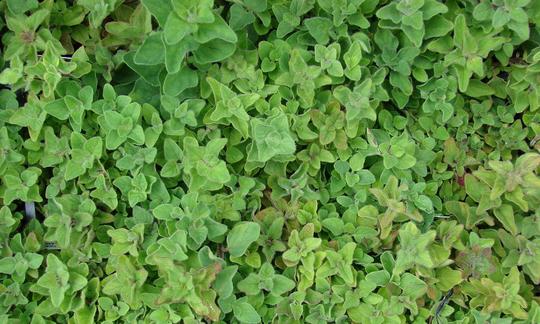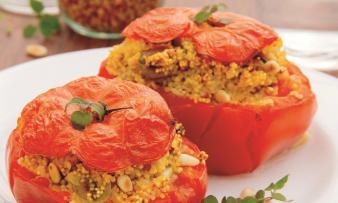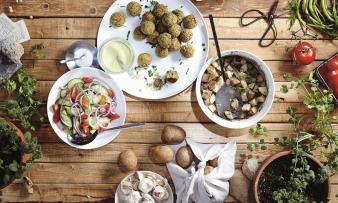Table of contents
The winter-hardy real Greek oregano ( Origanum vulgare subsp. hirtum) has the most intense flavor of known oregano subspecies (varieties). Fresh and organic, it is a popular herb.
Use in the kitchen
Real Greek oregano has a particularly intense, heat-resistant flavor that is not lost even when cooked. Compared to other subspecies, Greek oregano has the best quality in terms of the essential oils that are crucial for the flavor. 15 On a scale of 1 to 10 for intensity and flavor, Greek oregano gets a value of 10, and marjoram ( Origanum majorana) gets a value of 3. It thus also surpasses Syrian oregano ( Origanum maru).
Only the real Greek oregano and Cretan oregano have white flowers, whereas Turkish oregano and summer marjoram have pink flowers or Russian oregano have violet flowers. For details about the seven different oregano subspecies, see the very bottom. Oregano plays a rather minor role in German cuisine. It is popular in Greek, Italian and Spanish cuisine. Oregano has a tart, peppery-bitter taste.
Can you eat oregano raw? Fresh oregano can be eaten without prior heating and tastes delicious in salad dressings and raw vegetable salads, for example in a Greek salad with tomatoes, cucumbers, black olives and red onions in an oil-free salad dressing.
What do you use oregano for? Fresh Greek oregano goes perfectly with steamed tomatoes, tomato sauce or in a pepper soup. It also tastes delicious in vegetable casseroles, with roast potatoes, on pizza or in stews. The herb harmonizes with most Mediterranean dishes and goes well with Italian herbs such as sage, bay leaves, basil and marjoram.
Dried oregano is also popular for reasons of durability. Along with dried thyme, rosemary and savory, oregano is present in most " Herbes de Provence " mixtures.
Vegan recipe for oregano pesto
Ingredients (for 2 people): 1 bunch of fresh oregano, 3 garlic cloves, 40 g walnuts, 2 tbsp yeast flakes, 40 ml lemon juice, 1 pinch of salt,black pepper. Optional: drinking water.
Preparation: Peel the garlic cloves. If necessary, wash the oregano briefly in cold water and shake out the water. Carefully pluck the leaves from the branches. Puree the garlic cloves together with the oregano leaves, walnuts, yeast flakes and lemon juice in a blender until smooth. Season with salt and pepper. If necessary, add a little drinking water if the mixture is too dry.
Tea preparation
Oregano tea is easy to make yourself using fresh oregano. To do this, carefully pluck the leaves from the stem or cut them off with scissors. Pour 250 ml of hot water over 2 tablespoons of oregano leaves and leave to steep, covered, for 5 minutes. Then strain the leaves and sweeten with honey if necessary.
Vegan recipes with fresh oregano can be found under the note: " Recipes that have the most of this ingredient ".
| Not only vegans or vegetarians should read this: Vegans often eat unhealthily. Avoidable nutritional errors. |
Purchasing - Storage
At major retailers such as Coop, Migros, Spar and Rewe you can find fresh oregano in larger branches, sometimes even in organic quality. Denner, Volg, Aldi, Lidl, Edeka, Hofer and Billa usually only have dried oregano in their range. Organic supermarkets such as Denn's Biomarkt and Alnatura also occasionally sell fresh oregano.
In its pollutant check on September 23, 2020 , Stiftung Warentest found very large differences between suppliers (34 brands), including some organic products. However, it was not about Greek products, but rather "vulgare" (21 times, 9 of which were organic) and marjoram - and that in the dried form. They were looking for pyrrolizidine alkaloids (PA) and pesticides in particular. Organic quality from Azaran, Herbaria and Lebensbaum passed the test without any problems. Three non-organic products had to be advised against due to health concerns! 16
The availability of fresh oregano varies depending on the size of the store, catchment area, etc. If you are interested, click on our recorded food prices for the DA-CH countries (above under the ingredient image). There you will find current prices and, by clicking, their development at various suppliers.
Wildly found
Wild oregano ( Origanum vulgare) can be found in the DA-CH countries on limestone and gravelly soils in warm places such as south-facing slopes, embankments, southern forest edges and poor meadows. 2 Greek oregano ( Origanum vulgare subsp. hirtum) can only be found growing wild.
Storage tips
If you use the oregano within a day, you can place it in a glass of water to keep it fresh. If you wrap fresh oregano in a damp cloth or put it in a foil bag, you can store it in the fridge for a few days. Frozen oregano will keep in the freezer for around a year. 3
Ingredients - Nutritional values - Calories
Here we realistically show you the ingredients of spices and herbs per 1 g (instead of per 100 g as usual).
1 g of fresh Greek oregano (raw) has a calorie content of 0.72 kcal. It contains 0.12 g carbohydrates, 0.02 g protein and 0.02 g fat. 1
Fresh oregano contains mainly iron (0.07 mg/1g) and calcium (0.03 mg/1g). 1 However, other fresh herbs have a much higher content. Herbs that are particularly rich in iron are green mint (0.12 mg), fresh marjoram (0.13 mg), fresh thyme (0.17 mg/1g) and wild mallow (0.78 mg). Lemon verbena (9.58 mg/1g) provides particularly high levels of calcium. 3
The complete ingredients of fresh oregano, the coverage of the daily requirement and comparison values with other ingredients can be found in our nutrient tables. In the article Nutrients explained you will get a detailed insight into the topic.
Effects on health
How healthy is oregano? Like Origanum vulgare, Greek oregano ( Origanum vulgare subsp. hirtum) contains valuable essential oils that can have a positive effect on health. These include large amounts of carvacrol and thymol, as well as terpinene (class of terpenes), linalyl acetate and p-cymene. The composition and content of the individual substances vary depending on the time of harvest, the geographical location, the environmental conditions and the parts of the plant used (stems, leaves). 5
In vitro studies show that oregano has antioxidant, antibacterial, antimicrobial and antifungal effects. 5 Essential oils from oregano could be promising for the medical and cosmetics industry. Due to its antimicrobial and antibacterial effects, the herb is sometimes advertised as a "natural antibiotic". Its effect in the treatment of severe acne is also being investigated. Initial results on a mouse model are promising. However, a commercially available preparation is not yet available (as of 2018). 10
Oregano essential oil can inhibit the formation of various food pathogens and food-spoilage organisms and thus contribute to food safety. 11,13 Initial studies on its applicability in the food industry are promising. The addition of oregano extracts extended the shelf life of olive oil and tuna salad, potato chips and roasted peanuts. When the potatoes were heated, less of the harmful acrylamide was formed. 14
Dangers - Intolerances - Side effects
Allergic reactions to oregano are rare, but can occur. There is a known case of a 45-year-old man who had allergic reactions after eating food containing thyme or oregano. In addition to itching and swelling of the lips and tongue, he also had difficulty swallowing, breathing difficulties, eyelid edema, hypotension (low blood pressure), vomiting and nausea. An allergic skin test showed that the man also reacted to other spices from the Lamiaceae family. The control group, on the other hand, did not react to any of the spices. 12
During pregnancy, you should avoid excessive consumption of oregano, even as tea or oil. Oregano is considered to induce labor. As a seasoning in the kitchen, it is generally safe even during pregnancy and breastfeeding. 2.9
Use as a recognized medicinal plant
Oregano ( Origanum vulgare) and Greek oregano ( Origanum vulgare subsp. hirtum) are not recognized medicinal plants. HMPC ( Committee on Herbal Medicinal Products) and ESCOP ( European Federation of National Societies for Phytotherapy) have not yet dealt with this spice. Commission E issued a negative monograph on the grounds of insufficient evidence of effects for oregano ( Origanum vulgare). 4
Folk medicine - natural healing
Oregano tea is used in a similar way to thyme for respiratory problems such as coughs (whooping cough) and bronchitis. It is also used as a bath additive for colds. It is also said to help with digestive disorders, diseases of the stomach and intestinal tract, diarrhea and abdominal complaints. Oregano tea is rarely used as a gargle for throat and mouth infections. 2,4
Ecological footprint - animal welfare
The CO 2 footprint of a food depends on various factors. The type of agricultural production (conventional vs. organic), average or seasonal or regional production, domestic production or import by truck, ship or plane, different types of packaging and whether the goods are fresh or frozen play a decisive role. 17 In a study on the ecological footprints of different herbs with different cultivation methods, an ecological CO 2 footprint of 0.069 kg CO 2 eq/kg was found for oregano from organic farming, and 0.089 kg CO 2 eq/kg for oregano from conventional farming. 18 The increased value for conventional oregano results from the use of pesticides and synthetic fertilizers, the use of which is prohibited in organic farming. Ideally, you should buy oregano from organic farming or grow it yourself, which also saves unnecessary transport and packaging.
The amount of water needed to produce 1 kg of oregano is about 325 litres. 18
Due to its high sugar content, the oregano flower is very attractive to pollinators such as bees, but also butterflies or hoverflies 19 and can thus contribute to an insect-friendly garden or balcony.
Worldwide occurrence - cultivation
Oregano originally comes from the Mediterranean region, but also grows in Central Europe on limestone and gravel soils in sunny locations. 2 The herb is also found on the east and west coasts of North America. 5 Oregano is a popular spice, which is why it is often grown in the garden or in a pot on the balcony. The main growing area for commercially produced oregano is Turkey. 5
Cultivation - Harvest
The plant prefers a sheltered, warm, sunny location. The soil should be relatively low in nutrients and permeable to water. The herb can be grown well in a pot on the balcony. Oregano does not like waterlogging at all, which is why permeable soil with good drainage is important. 6
From the end of February you can sow oregano for pre-cultivation so that you can plant it out from May. Alternatively you can sow directly outdoors from the end of May. Oregano is a light germinator, which means that the seeds must not be covered with soil. 6
In contrast to other varieties, Greek oregano is relatively hardy (down to -15 °C). From mid-August onwards, you should stop fertilising and cutting back the herb. Both of these things encourage the formation of new shoots, which will not fully mature by winter and can therefore freeze. The ground around the plant should be covered with fir or spruce branches to protect the roots from frost. 7
You can harvest the fresh leaves and shoots of oregano at any time. However, you should not harvest the plant completely after flowering, as it will not be able to grow enough again until winter. To dry it, cut it off about 15 centimeters below the flower during flowering. 6
Further information
Oregano ( Origanum vulgare) belongs to the genus Oregano or Orant ( Origanum) in the mint family (Lamiaceae). Well-known oregano species are Greek oregano ( Origanum vulgare subsp. hirtum), Turkish oregano ( Origanum onites), Syrian oregano ( Origanum maru) and marjoram ( Origanum majorana). Mexican oregano ( Lippia graveolens ; Spanish: hierba dulce), however, belongs to the Verbenaceae family.
What does oregano look like? Oregano is a perennial herb and sprouts anew every year from a richly branched rootstock. The 40 to 60 centimetres high, square and upright stems become slightly woody towards the bottom. The leaves are egg-shaped to elongated and slightly hairy. They are about three centimetres long. From July to September, oregano bears flowers of different colours in umbels or panicles, depending on the subspecies. The real Greek oregano flowers white. 7,8
Alternative names
Common names for oregano are Dorst, Dost, True Dost, Common Dost, Common Marjoram or Wild Marjoram. Greek oregano is a subspecies that is also called false marjoram, Greek oregano, Italian oregano and pizza oregano.
The English name is oregano.
Bibliography - 18 Sources
| 1. | DEBInet, Deutsches Ernährungsberatungs- & -informationsnetz. Bundeslebensmittelschlüssel 3.02, Oregano frisch. |
| 2. | Apotheker Pahlow M. Das grosse Buch der Heilpflanzen. Gesund durch die Heilkräfte der Natur. Hamburg: Nikol Verlagsgesellschaft mbH & Co. KG; 9. Auflage. 2020. |
| 3. | USDA United States Department of Agriculture. |
| 4. | Kooperation Phytopharmaka. Arzneipflanzenlexikon. Dost - Gewöhnlicher Dost (Origanum vulgare ssp. hirtum). |
| 5. | Lombrea A, Antal D, Ardelean F, Avram S, Pavel IZ, Vlaia L, Mut AM, Diaconeasa Z, Dehelean CA, Soica C, Danciu C. A Recent Insight Regarding the Phytochemistry and Bioactivity of Origanum vulgare L. Essential Oil. Int J Mol Sci. 2020 Dec 17;21(24):9653. |
| 6. | Plantura.garden Oregano anbauen: Der mediterrane Klassiker im eigenen Garten. |
| 7. | Plantura.garden. Griechischer Oregano: Unterschiede zum gewöhnlichen Pizzakraut. |
| 8. | Mein schöner Garten. Oregano. |
| 10. | Taleb MH, Abdeltawab NF, Shamma RN, Abdelgayed SS, Mohamed SS, Farag MA, Ramadan MA. Origanum vulgare L. Essential Oil as a Potential Anti-Acne Topical Nanoemulsion-In Vitro and In Vivo Study. Molecules. 2018 Aug 28;23(9):2164. |
| 11. | Rodriguez-Garcia I, Silva-Espinoza BA, Ortega-Ramirez LA, Leyva JM, Siddiqui MW, Cruz-Valenzuela MR, Gonzalez-Aguilar GA, Ayala-Zavala JF. Oregano Essential Oil as an Antimicrobial and Antioxidant Additive in Food Products. Crit Rev Food Sci Nutr. 2016 Jul 26;56(10):1717-27. |
| 12. | Benito M, Jorro G, Morales C, Peláez A, Fernández A. Labiatae allergy: systemic reactions due to ingestion of oregano and thyme. Ann Allergy Asthma Immunol. 1996 May;76(5):416-8. |
| 13. | Schillaci D, Napoli EM, Cusimano MG, Vitale M, Ruberto A. Origanum vulgare subsp. hirtum essential oil prevented biofilm formation and showed antibacterial activity against planktonic and sessile bacterial cells. J Food Prot. 2013 Oct;76(10):1747-52. |
| 14. | Ortega-Ramirez LA, Rodriguez-Garcia I, Silva-Espinoza BA, Ayala-Zavala JF. Chapter 71 - Oregano (Origanum spp.) Oils. In: Preedy flavor and safety VRBT-EO in FP. San Diego: Academic Press; 2016; 625-631. |
| 15. | Peter KV, editor. Handbook of herbs and spices. Vol. 2. Boca Raton, Fla.: CRC Press; 2004. 360 p. (Woodhead publishing in food science and technology; vol. 2). |
| 16. | Stiftung Warentest: 34 Küchenkräuter im Schadstoffcheck |
| 17. | Reinhardt G, Gärtner S, Wagner T. Ökologische Fussabdrücke von Lebensmitteln und Gerichten in Deutschland. Institut für Energie - und Umweltforschung Heidelberg. 2020. |
| 18. | Litskas V, Chrysargyris A, Stavrinides M, Tzortzakis N. Water-energy-food nexus: A case study on medicinal and aromatic plants. Journal of Cleaner Production. 2019; 1334-1343. |
| 19. | Wir für Bienen. Oregano. Aufgerufen am 05.09.2023 auf https://www.wir-fuer-bienen.at/oregano |











Comments